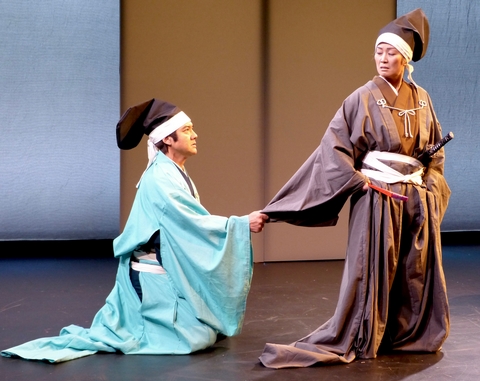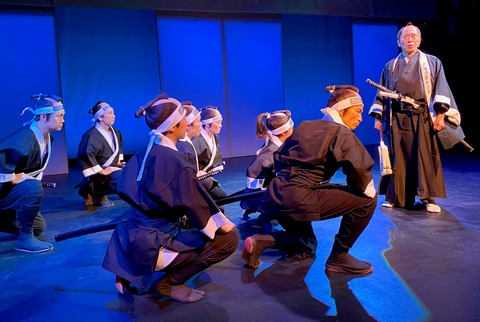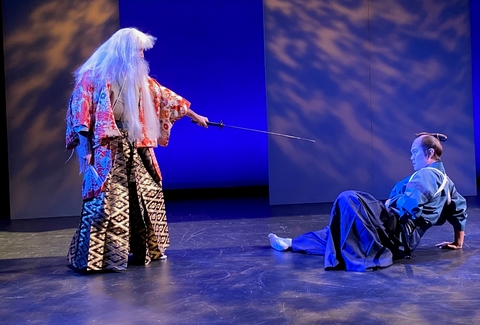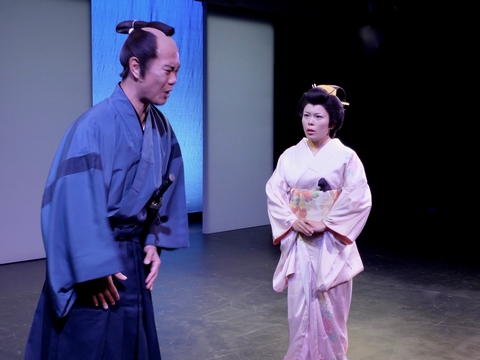Chushingura – 47 Ronin
A classic Japanese tale staged with care and reverence.

Yasu Suzuki and Hiroko Yonekura in a scene from Amaterasu Za’s production of “Chushingura – 47 Ronin” at A.R.T./New York Mezzanine Theater (Photo credit: Melinda Hall)
[avatar user=”Joel Benjamin” size=”96″ align=”left”] Joel Benjamin, Critic[/avatar]
Chushingura – 47 Ronin, a classic in Japanese culture, is based on actual events from the early 18th Century. The tale has been related in Kabuki, Bunraku, novels, feature film and TV series versions with some modern incarnations updating the action and relocating it to different locales.
Amaterasu Za is presenting a chamber version of this very complicated story adapted and directed by Amaterasu Za founder Ako Dachs who also designed the splendid period costumes that illuminated the differences beween the upper crust characters and the hoi-polloi servant class. If all that creativity weren’t enough, she also served as the genial, incisive narrator of the play, the only English spoken during the two hour show. The scenario is otherwise delivered in Japanese with super-titles—sometimes ill-coordinated with the dialogue—projected upon the set.
In a society in which a misdirected glance could lead to death and where even the Emperor didn’t have ultimate power over the ruling Shoguns, Chushingura tells the tale which unfolds slowly, very slowly.

Yoshi Amao and the cast of Amaterasu Za’s production of “Chushingura – 47 Ronin” at A.R.T./New York Mezzanine Theater (Photo credit: Melinda Hall)
Asano (Yasu Suzuki) is forced by the Emperor to host a reception in Edo for representatives from the Imperial Court in Kyoto (then the capital of Japan). Also involved was Kira (Hiroko Yonekura in a gender-bending performance) whom the Emperor appointed to keep Asano informed about the strict protocols involved in such an event.
For unknown reasons, on the day of the event, Asano pulled a sword and tried to kill Kira. Asano was not only sentenced to commit ritual seppuku (suicide), but all his properties were confiscated.
Several years later Kira, himself, is assassinated by the 47 Ronin (warriors unanchored to a Shogun) led by Oishi (Rina Maejima, another female playing a male). Oishi and his ronin cohorts were all sentenced to seppuku.

Jun Suenga and Koji Ono in a scene from Amaterasu Za’s production of “Chushingura – 47 Ronin” at A.R.T./New York Mezzanine Theater (Photo credit: Melinda Hall)
Chushingura relates these events in a highly ritualized form filling out the storyline with subsidiary characters like servants, spouses and lower ranked officials, all hampered by the social laws dictating their behavior. When one character is approached by her brother to get him into her household, she is severely berated by her master. Such were the restrictions of 18th century Japan.
Amaterasu Za’s version, using a cast of just nine actors, most playing several roles, is stripped down to essentials, including the scenery, mostly consisting of several plain screens, possibly to evoke simple Japanese interiors.
Chushingura would benefit from some slides to illuminate the different locales portrayed and to add some visuals to the well-acted proceedings. Title slides and line translations were projected quite helpfully, so the technology is clearly within the ability of the troupe’s technical staff.

Koji Ono and Saori Goda in a scene from Amaterasu Za’s production of “Chushingura – 47 Ronin” at A.R.T./New York Mezzanine Theater (Photo credit: Melinda Hall)
These performers, helped by Joshua Dachs’ sets, Ako Dachs’ costumes, Mitsuteru Okuyama’s sensational wigs, ethnic music and Aaron Bowersox’s fine, atmospheric lighting, gave their energetic all to the vocal and physical demands of their characters, bringing this classical tale to life.
It’s not clear what Amaterasu Za’s mission is. If, as Dachs’ program comments indicate, it is to bring Japanese culture to modern audiences, the company needs to be less stodgy and more contemporary in its approach to such vivid dramas as Chushingura.
If this production is representative of their efforts, Amaterasu Za is dedicated to first rate representations of high Japanese art. Their standards are high. Perhaps, Dachs and her company can figure out how to combine a reverence for traditional Japanese theater with appealing to a wider audience without sacrificing authenticity.
Chushingura – 47 Ronin (through November 6, 2022)
Amaterasu Za
A.R.T./New York Mezzanine Theater, 502 West 53rd Street, in Manhattan
For tickets, visit http://www.amaterasu.ticketspice.org
Running time: two hours including one intermission


Leave a comment